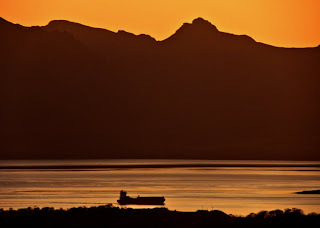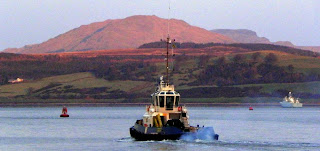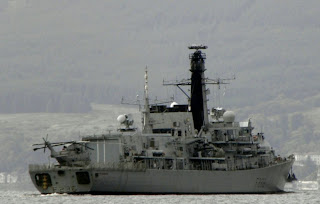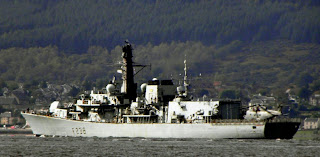 A small coaster passing Little Cumbrae with Arran in the background.
A small coaster passing Little Cumbrae with Arran in the background.
Search This Blog
Saturday 27 February 2010
Friday 26 February 2010
Thursday 25 February 2010
Wednesday 24 February 2010
Maersk Lay up ships

From Lloyd's List:
Maersk comes to terms with pastures new
When Maersk Line decided to anchor six boxships on Loch Striven there was little practical advice available on lay-up procedures. Janet Porter visited the site and spoke to senior company officials about the challenges of shutting down modern vessels
Janet Porter
12 February 2010 Lloyds List
HOT lay-up. Cold lay-up. Warm lay-up. A whole lexicon of shipping terms has been dusted off over the past year as shipowners confronted the worst industry-wide slump ever that has forced the de-activation of vessels on an unprecedented scale.
Yet few of those working in shipping today, either at sea or ashore, had any first-hand experience of decommissioning vessels, particularly those packed with computers and other electronic equipment that were not around during the tanker crisis of the late 1970s and early 1980s, the last period of mass lay-ups.
Certainly, containerships had never been mothballed before the recession that deepened throughout 2009. So when Maersk Line, along with many others, came to the conclusion that there was no alternative but to remove ships from active service, there was little guidance available.
“We really had to start from scratch,” recalls Tony Greener, Maersk’s UK fleet group manager, who has been responsible for the lay-up programme since the Danish line chose Loch Striven in Scotland to park six of its ships.
How that project has been handled has become a showcase for other owners, as the whole industry pools information and experience through their classification societies.
Five of the ships that Maersk has mothballed for at least 18 months were built for a different era. Although only delivered from the German yard Volkswerft Stralsund in 2006 and 2007, the 4,170 teu Maersk Beaumont , Maersk Brooklyn , Maersk Bentonville , Maersk Boston and Maersk Baltimore were among the first to be picked for lay-up, largely because of their design.
They were tailor-made for the Asia-US east coast trades with service speeds of 30 knots. In fact, the Maersk Boston reached 32 knots during sea trials.
But as fuel prices soared and slow-steaming became the norm on many trades, the five UK-flag vessels were deemed too expensive to operate efficiently, and sent to Loch Striven, on Scotland’s west coast close to Glasgow.
First to arrive was a much older unit, the black-hulled 1985-built 4,200 teu Sealand Performance , back in June, followed almost immediately by the Maersk Beaumont . The other four joined them in the following months.
All six are now rafted together, top-to-tail, in the middle of the loch, some 500 m from either shore and about 20 minutes by launch from the nearby town of Rothesay. Another two Maersk ships, Maersk Maryland and Maersk Maine , are laid up in nearby Greenock, while the line has others at anchor in various locations around the world including Piraeus and Laem Chabang in Thailand.
Although the Loch Striven sextet are classed either with ABS or Lloyd’s Register, it was the Norwegian classification society DNV that had the best guidelines in place for certain procedures, and which Maersk used as a reference. Ships had been laid up on Loch Striven in the past, but local port authority Clydeport had no useful records setting out best practices, while very little anecdotal advice existed either. “We have had to make it up as we go along,” Mr Greener says.
But starting afresh has not necessarily been a drawback, since sticking closely to procedures used 30 years ago could have led to unforeseen problems.
“Much better to establish our own rules,” Mr Greener says.
First, the ships have to be carefully positioned to ensure they are not vulnerable to katabatic winds blowing down through the valleys.
Main engines are shut down on all six ships but two of the anchored vessels, Maersk Beaumont and Maersk Bentonville , act as motherships for the other four that are in semi-cold lay-up, providing power for heating and lighting through auxiliary generators.
That has enabled all six to be maintained by a team of just 10 engineers, led by David Johnstone, who has been in charge of the raft since September, and who has played a key role in winning over the local community.
For that is an added challenge for any shipowner wanting to find a safe harbour for unemployed tonnage.
Although the banks of Loch Striven are sparsely populated, the few householders living near by were shocked and angry when the ships first arrived unannounced, and kicked up an enormous fuss about the scar on their stunning landscape.
A charm offensive by Maersk, with locals invited to tour the ships and hear first hand why lay-up was necessary, has worked wonders. Maersk also undertook audits in response to complaints that residents were being disturbed by the noise, and subsequently was able to switch off some equipment.
“We are getting on fine now,” says Capt Johnstone, who is on first name terms with his shoreside neighbours, often pops in for tea, and is a well-known and popular figure in Rothesay.
The feeling is reciprocated, with one of those who was most hostile when the ships first anchored in Loch Striven telling Lloyd’s List that “they are no bother”.
In fact, the vessels are proving to be something of a tourist attraction, with some townfolk pleased to see shipping activity returning to Loch Striven for the first time in years.
Helping matters is the fact that Maersk is giving the local economy a welcome boost, with provisions and other supplies bought in Rothesay, and visiting staff frequenting the town’s hotels and restaurants. The company is also donating fees paid by the BBC, which is filming a sci-fi game show on one of the ships, to local causes.
Mission:2110, scheduled to be broadcast in April, is set in an apocalyptic landscape that, the BBC concluded, could best be reproduced in the cargo hold of a containership. The film crew, along with 16 children aged between 12 and 14, plus a teacher, are all living on the vessels alongside the resident ships’ officers, and getting along fine.
Mr Greener admits he was reluctant to agree when first approached by the BBC, but says having an extra 70 people onboard has not been a problem. Neither did Maersk raise objections when the BBC decided that the easiest way to lower camera equipment and the towering robots that star in the show down into the hold was to cut holes in the hatchcovers, since there were no cranes onboard to lift them.
His principal concern is to ensure all the machinery on the six ships is kept in good working order, so that the vessels could be reactivated within about 10 days, should the need arise.
Damp is the biggest problem, with dehumidifiers kept running at all times throughout the ships to keep the electronics and other equipment dry, with the doors to the giant 12-cylinder engines left open to allow the air to circulate and stop condensation forming.
But no paint work or other cosmetic refurbishment will be done during lay-up, with the ships likely to go in to dry dock for a full makeover before returning to service.
The next step is to see if all six ships could be powered from just one mother vessel in order to cut running costs and reduce the size of the maintenance squad to eight engineers.
But Mr Greener does not think more ships could be added to the raft, with experience suggesting that six is the maximum.
The one concern arose when the whole raft shifted by about 25 m during a particularly fierce storm, but as soon as the bad weather subsided, the ships settled back to their original position.
For Capt Johnstone, the day begins with a lengthy tour of all six ships to check the anchors and moorings, and he insists on maintaining normal onboard discipline and routine, despite the far from normal surroundings.
The one downside for anyone working on the ships anchored in British waters is the fact that they become liable for UK tax.
That is “a sore point” for those onboard who would be exempt if they were at sea, Capt Johnstone admits. But with Maersk making some British officers redundant as the fleet is trimmed, they know they are lucky to have jobs. Most have volunteered for the Loch Striven posting.
The line will not release financial figures about the lay-up programme, other than to say it probably spends some $1,500 a day per ship on port dues and running costs. Tug fees and other expenses associated with positioning ships came to around $100,000.
So what next for the Loch Striven ships?
Maersk has said it expects them to stay in lay-up until the end of 2010. In anticipation of their eventual return to service, they have been filled with low-sulphur fuel that has become mandatory since the ships were put into lay-up.
In the meantime, work is going on behind the scenes to see if the hull form should be re-modelled into a better shape for slow-steaming and the ships perhaps shortened without losing container capacity, or possibly re-engined.
But in reality, it is likely to be some time before the Loch Striven six are back on the high seas, with the world’s container trades still a very long way from profit and lay-up expected to remain a feature of the industry for several years to come.














































